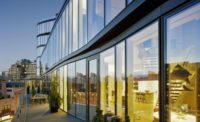Higher Ed Design Adapts and Evolves to Better Support Wellness
From student centers to athletic facilities, architectural design holistically addresses students’ modern needs in a dynamically changing landscape

Image courtesy of Spiezle
The modern college student needs campus environments that protect, support, and promote their academic success and all dimensions of their mind, body, and spirit. In its latest findings, the Healthy Minds Network noted, “College campuses present a unique setting for intervening and fostering student well-being. The age of college students typically coincides with the age of onset of mental health concerns.”
Architects are well-positioned to help college campuses and students create places and experiences outside the classroom that cater to their physical and psychological well-being and performance. Planners and designers must collaborate with college personnel and student bodies to ensure these spaces apply a holistic approach to student wellness, health and fitness. A scan of the latest headlines for college students shows that “unplugging” is more complex than ever due to the increase of technology. With the prevalence of anxiety, depression, eating disorders, suicidal ideation, and other challenges, students find it increasingly difficult to feel at ease, balanced, creative, and productive.
In higher education, the client is the student, including their individual backgrounds, interests and expectations. Architects can meet their needs in creative and customized ways by examining current conditions and targeting improvements for campus recreation spaces, student centers, and athletic facilities. Ongoing demographic changes, including the onset of a steep decline in college-age students and a shifting population, coupled with increased competition for enrollment, are also reshaping the design and planning process.
To meet these challenges head-on, forward-looking higher education institutions are bringing in design partners to address mental health, athletic performance, student productivity, and creativity with unique solutions. For instance, a Zen Den was designed to reimagine a former computer lab to address specific student needs at Rider University. The goal was to create a place that reduces stimulation so students could take a break from their busy schedules. The Zen Den also supports the growing population of neurodivergent students who struggle with over-stimulation and other conditions that can negatively impact their learning and interpersonal development.
Connectivity to nature is an important component of mental health and wellness, and biophilic design features were implemented in the Zen Den to achieve a sense of calm, including a large mural depicting a forest scene that reconnects students with nature. Sensory touch lights also simulate nature, allowing students to engage with their environment in a calming, rejuvenating manner to take their minds off coursework, tests, and technology. Rider University’s student government advocated and dedicated funding for the Zen Den as well as rallied faculty and campus administrators to spearhead and support the renovation. There is a clear drive and demand amongst students to create campus spaces that serve them as a whole and create a distinct educational experience that nurtures the entire body and mind.
“Students work incredibly hard on their scholastic pursuits, yet that singular drive often requires a mental recalibration throughout the day that the Zen Den provides,” said Leanna Fenneberg, former Vice President of Student Affairs at Rider University. “Intentional architectural design can greatly improve student well-being and mental health outcomes.”
Cranberry Cafe in the Bart Luedeke Center of Rider University is an example of incorporating student feedback into a space that encourages community while offering various options to meet student schedule demands. Quick-service food stations that allow grab-and-go play a role in supporting student health and mental wellness by providing convenient access to meals. Having easily accessible food options on campus, including those that are healthier, organic, and allergy-considerate, is crucial for supporting the well-being of students who often have busy schedules juggling classes, extracurricular activities, and study time. Additionally, the option to sit and enjoy a meal with friends can contribute to students' mental wellness by fostering social connections and providing a space for relaxation and community building.
Additionally, as the population of college students declines and more young people pursue trade certificates and technical training, the atmosphere for student-athletes to choose one school over another gets even more competitive. Schools are taking a detailed look at longer-term plans that align with their strategies for evolving an entire campus. For example, Atlantic Cape Community College implemented an Athletics Master Plan to evaluate the conditions of their buildings and develop plans to update older facilities and increase the number of competitive sports programs across ACCC’s campuses. Alongside a focus on maintaining equity for male and female sports programs at the institutional level, ACCC broadened its campus mental health support systems. The excitement for architects and designers partnering with colleges and universities is that these institutions are motivated to respond to the true mission of higher education to support and develop the individual student learner.
Putting students’ needs first in wellness and physical activity spaces contributes to a healthier overall school environment. As college students' challenges continue to evolve, the student center and athletics facilities will become increasingly important for supporting their physical and mental wellness. A holistic approach where all acknowledge the correlation between the mind, body, and soul and how physical spaces can play a prime role in supporting and developing each facet of a student’s wellness will help colleges evolve to meet modern student needs. Creative and engaging design leads to recruitment success, setting universities apart and creating environments that serve students in their education and mental health, driving successful outcomes and creating long-term success for both the university and their student body.
Looking for a reprint of this article?
From high-res PDFs to custom plaques, order your copy today!







